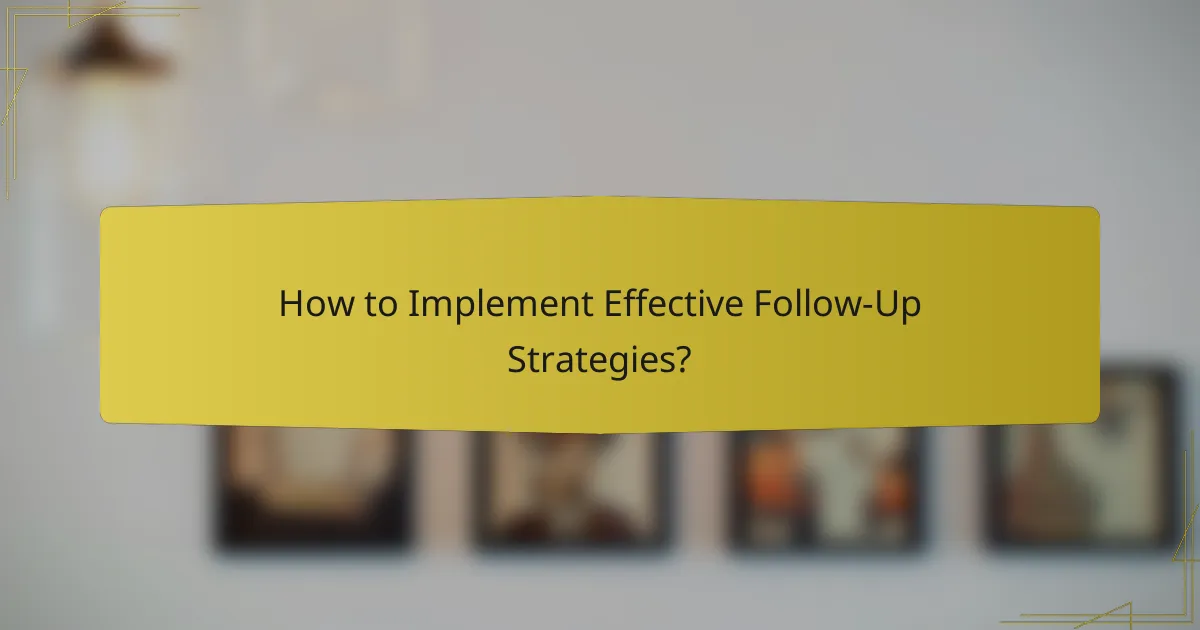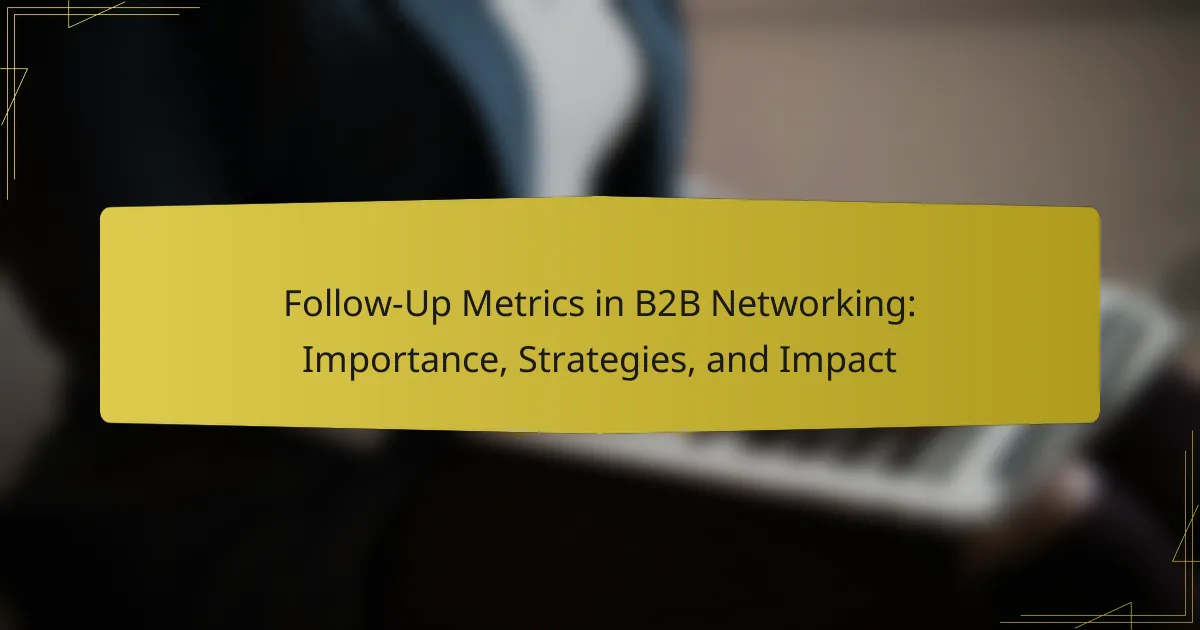Follow-up metrics play a vital role in B2B networking by offering valuable insights into the success of interactions and guiding future strategies. By closely monitoring metrics such as response rates and lead conversion rates, businesses can refine their networking efforts to foster stronger relationships and drive better results.

Why Are Follow-Up Metrics Important in B2B Networking?
Follow-up metrics are crucial in B2B networking as they provide insights into the effectiveness of interactions and help refine strategies for future engagements. By measuring these metrics, businesses can enhance their networking efforts and achieve better outcomes.
Enhances relationship building
Tracking follow-up metrics allows businesses to understand how their interactions impact relationships with clients and partners. For instance, measuring response times and engagement levels can highlight which approaches foster stronger connections. Regularly assessing these metrics helps tailor communication strategies to meet the preferences of different stakeholders.
To enhance relationship building, consider scheduling follow-ups based on previous interactions and noting preferences for communication channels. This personalized approach can significantly improve rapport and trust over time.
Improves conversion rates
Follow-up metrics directly influence conversion rates by identifying which touchpoints are most effective in moving prospects through the sales funnel. By analyzing data such as email open rates and meeting follow-ups, businesses can refine their tactics to increase the likelihood of closing deals.
For example, if follow-up calls result in higher conversion rates than emails, prioritize phone outreach. Regularly reviewing these metrics enables businesses to adapt their strategies and focus on the most impactful methods.
Facilitates data-driven decisions
Utilizing follow-up metrics empowers businesses to make informed, data-driven decisions regarding their networking strategies. By analyzing trends and patterns in engagement, companies can identify successful tactics and areas needing improvement.
Establish a system for collecting and reviewing these metrics regularly. This could involve using CRM software to track interactions and outcomes, allowing for a clearer understanding of what drives success in B2B networking.
Increases accountability
Follow-up metrics enhance accountability within teams by establishing clear benchmarks for performance. When team members know that their follow-up actions are being measured, they are more likely to prioritize timely and effective communication.
To foster accountability, set specific goals for follow-up activities, such as the number of follow-ups per week or response time targets. Regularly review these metrics in team meetings to encourage a culture of responsibility and continuous improvement.
Strengthens brand reputation
Consistent follow-up metrics contribute to a strong brand reputation by demonstrating reliability and professionalism in B2B interactions. When businesses are prompt and effective in their follow-ups, they build trust and credibility with clients and partners.
To strengthen brand reputation, ensure that follow-up communications reflect the company’s values and commitment to customer service. Regularly measuring and improving follow-up effectiveness can lead to positive word-of-mouth and long-term loyalty from clients.

What Follow-Up Metrics Should B2B Professionals Track?
B2B professionals should track follow-up metrics to gauge the effectiveness of their networking efforts. Key metrics include response rate, engagement level, lead conversion rate, follow-up frequency, and customer satisfaction score, each providing insights into different aspects of the follow-up process.
Response rate
The response rate measures the percentage of contacts who reply to follow-up communications. A higher response rate indicates effective outreach strategies and engagement with the target audience. Aim for a response rate of at least 20-30% for initial follow-ups, adjusting your approach based on industry standards.
To improve response rates, personalize your messages and clearly state the value proposition. Avoid generic templates, as tailored communication tends to resonate better with recipients.
Engagement level
Engagement level assesses how actively contacts interact with your follow-up content, such as emails, calls, or meetings. This can be measured through metrics like open rates, click-through rates, and meeting attendance. High engagement levels suggest that your follow-up efforts are relevant and valuable to your audience.
To enhance engagement, consider using interactive content or asking open-ended questions that encourage dialogue. Regularly analyze engagement data to refine your communication strategies and focus on what resonates most with your audience.
Lead conversion rate
The lead conversion rate indicates the percentage of leads that become paying customers after follow-up efforts. This metric is crucial for evaluating the effectiveness of your sales process and follow-up strategies. A typical conversion rate in B2B can range from 1% to 10%, depending on the industry and sales cycle.
To boost conversion rates, ensure that your follow-ups address the specific needs and pain points of your leads. Implementing a structured follow-up process with clear calls to action can significantly improve your chances of converting leads into customers.
Follow-up frequency
Follow-up frequency refers to how often you reach out to leads after the initial contact. Striking the right balance is essential; too frequent follow-ups can annoy potential clients, while infrequent ones may lead to lost opportunities. A common practice is to follow up within a week of the initial contact and then continue with periodic outreach every few weeks.
Establish a follow-up schedule that includes a mix of emails, calls, and value-driven content. Use a CRM system to track interactions and set reminders for follow-ups to maintain consistency without overwhelming your contacts.
Customer satisfaction score
The customer satisfaction score (CSAT) measures how satisfied customers are with your follow-up interactions and overall service. This metric can be gathered through surveys or feedback forms after a sale or significant interaction. A high CSAT score indicates that your follow-up efforts are meeting or exceeding customer expectations.
To improve customer satisfaction, actively seek feedback and be responsive to concerns. Regularly review CSAT data to identify areas for improvement in your follow-up processes and ensure that your customers feel valued and heard.

How to Implement Effective Follow-Up Strategies?
Implementing effective follow-up strategies in B2B networking involves personalized communication, timely responses, and the use of technology. These strategies ensure that connections are nurtured, leading to stronger business relationships and potential opportunities.
Personalized communication
Personalized communication is crucial for making a lasting impression in B2B networking. Tailor your messages to reflect the recipient’s interests, previous conversations, and specific needs. For example, referencing a recent discussion or a shared interest can enhance engagement.
Utilize the recipient’s name and relevant details to create a more intimate connection. Avoid generic templates, as they can come off as insincere and may lead to missed opportunities.
Timely follow-ups
Timely follow-ups are essential for maintaining momentum in B2B relationships. Aim to follow up within a few days after an initial meeting or conversation to keep the dialogue fresh. This demonstrates your commitment and interest in the partnership.
Establish a schedule for follow-ups, whether it’s a week, two weeks, or monthly, depending on the context of your interaction. Consistency is key, but ensure that follow-ups are spaced out enough to avoid overwhelming the recipient.
Utilizing CRM tools
CRM tools are invaluable for managing follow-up strategies effectively. These platforms help track interactions, set reminders for follow-ups, and store important information about contacts. Popular options include Salesforce, HubSpot, and Zoho CRM.
By leveraging CRM tools, you can automate follow-up reminders and maintain a history of communications, which aids in personalizing future interactions. This systematic approach can significantly enhance your networking efforts.
Setting clear objectives
Setting clear objectives for your follow-up strategies ensures that your efforts are focused and purposeful. Define what you want to achieve with each follow-up, whether it’s scheduling a meeting, sharing information, or simply maintaining contact.
Consider using the SMART criteria (Specific, Measurable, Achievable, Relevant, Time-bound) to outline your objectives. This clarity helps you stay on track and measure the effectiveness of your follow-up efforts.
Leveraging social media
Leveraging social media platforms can enhance your follow-up strategies by providing additional channels for communication. Engage with your contacts on platforms like LinkedIn, Twitter, or industry-specific forums to stay visible and relevant.
Share valuable content, comment on posts, and participate in discussions to foster relationships. This approach not only keeps you in your contacts’ minds but also positions you as a knowledgeable resource in your field.

What Tools Can Help Track Follow-Up Metrics?
Several tools can effectively track follow-up metrics in B2B networking, helping businesses monitor interactions and improve engagement. These tools provide insights into customer relationships, allowing for better decision-making and strategy adjustments.
HubSpot
HubSpot is a comprehensive CRM platform that offers robust tracking features for follow-up metrics. It allows users to log interactions, set reminders for follow-ups, and analyze email engagement rates. The reporting tools provide insights into which follow-ups are most effective, helping refine outreach strategies.
Utilizing HubSpot’s automation features can streamline follow-up processes. For example, you can create workflows that automatically send follow-up emails based on specific triggers, ensuring timely communication without manual input.
Salesforce
Salesforce is a leading CRM solution that excels in tracking follow-up metrics through customizable dashboards and reports. Users can track email opens, response rates, and meeting schedules, providing a clear picture of engagement levels. This data can be crucial for assessing the effectiveness of follow-up strategies.
Salesforce’s integration capabilities with other tools enhance its tracking functionalities. By connecting with email marketing platforms or social media tools, you can gather a comprehensive view of customer interactions across different channels.
Zoho CRM
Zoho CRM offers a user-friendly interface for tracking follow-up metrics, including email tracking and activity logging. It provides insights into customer engagement and allows for the segmentation of leads based on their interaction history. This segmentation helps tailor follow-up approaches to specific audience needs.
With Zoho’s automation features, users can set up reminders and follow-up tasks based on customer behavior, ensuring no lead is overlooked. This proactive approach can significantly enhance engagement rates and conversion potential.
Pipedrive
Pipedrive is designed with sales teams in mind, offering tools to track follow-up metrics effectively. Its visual pipeline allows users to see the status of each deal and schedule follow-ups accordingly. This clarity helps prioritize tasks and manage customer relationships more efficiently.
Additionally, Pipedrive’s reporting features enable users to analyze follow-up success rates, helping identify which strategies yield the best results. This data-driven approach supports continuous improvement in follow-up tactics.
Mailchimp
Mailchimp is primarily known for email marketing but also provides valuable insights into follow-up metrics. It tracks open rates, click-through rates, and engagement levels for follow-up emails, allowing businesses to gauge the effectiveness of their campaigns. This information is essential for refining messaging and timing.
Mailchimp’s automation tools can help schedule follow-up emails based on user interactions, ensuring timely communication. By segmenting your audience, you can tailor follow-ups to specific groups, enhancing the relevance and effectiveness of your outreach efforts.
